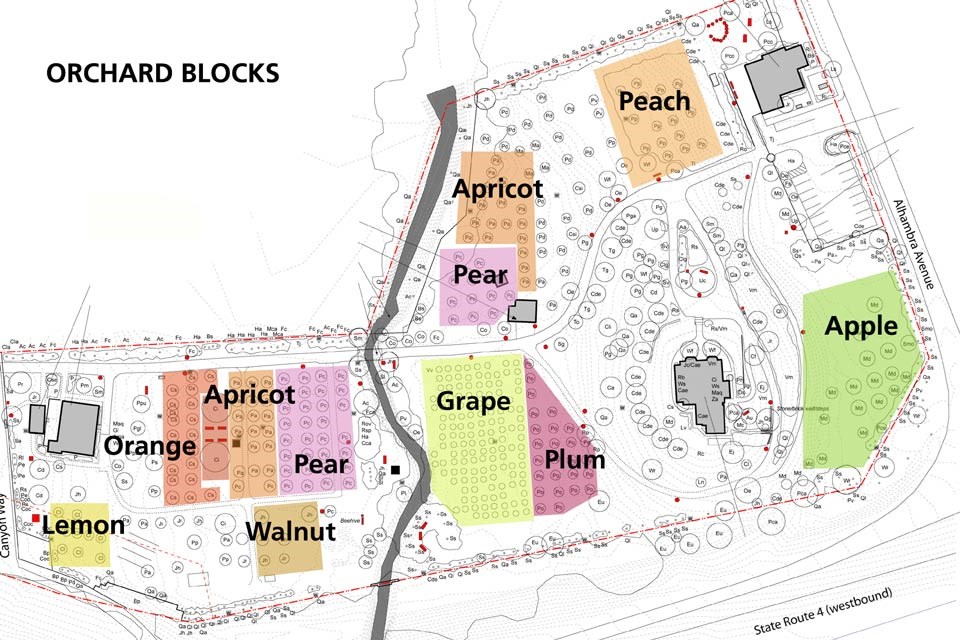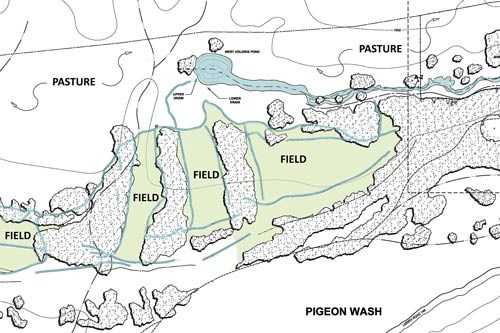Cultural landscapes that are composed of modular units, or have features that are modular in nature or by design, are more resilient to stress than landscapes with a more singular form. Modules may include different character areas, land use areas, ecosystems, or cultivated areas, whereas modular features may include orchards, fields, forests, or gardens. Modularity increases resilience by allowing a unit of a landscape or a feature to persist or function independently during a disturbance that has an impact on the rest of the landscape or other features.
At John Muir National Historic Site in Martinez, California, the NPS maintains multiple blocks of different species or varieties of trees within historic orchards of the cultural landscape. The modularity afforded by multispecies or multivariety blocks allows for some fruit yield even when late frosts damage some trees in bloom. The fruit species include almonds, apricots, cherries, grapes, peaches, pears, European plums, Japanese plums, and black and English walnuts. Dating back to the life of American conservationist John Muir, each orchard block includes multiple varieties that bloom at different times, affording natural protection from late frost damage. This modular pattern is a component of the landscape employed by Muir, who made his livelihood from commercial fruit growing in an area where late frosts were always a threat. Both the diversity and modularity of these planting units enhance the resilience of the landscape, and the pattern is perpetuated in the rehabilitation treatment plan.13

NPS
Seasonally, cattle would be herded into selected fields for grazing and watering, and then rotated to other fields when grasses were depleted. The modular design of the landscape was integral to the success of ranching in an arid environment that receives less than ten inches of rainfall per year. Today, the modular field and irrigation system is preserved by the NPS as a significant characteristic of the cultural landscape, helping visitors to understand how early settlers and their cattle could survive in this dry place.

John Muir’s orchards in California and Tassi cattle ranch in Arizona reflect historic modular patterns that have been used in non-technologized agricultural landscapes for thousands of years. Modularity, whether found in the olive terraces of ancient Palestine or the rotational three-field systems of Anglo Saxons, reflects a human response to a scarcity of resources or stressors that threaten economic activities. The integration of modular patterns in cultural landscapes reveals evidence of traditional knowledge of this resilience strategy. The concept of modularity can be applied in rehabilitation treatment design or during preservation maintenance to enhance the resilience of landscapes.
13. Susan Dolan, with Kimball Koch and David Blackburn, Orchard Management Plan for John Muir National Historic Site (Seattle, Wash.: National Park Service, Pacific West Region, 2006); Jeffrey Killion, Cultural Landscape Report for John Muir National Historic Site (Boston, Mass.: National Park Service, Olmsted Center for Landscape Preservation, 2005). See also Christopher Beagan and Keith Park, Practicing Sustainability, Case Study: John Muir National Historic Site, National Park Service Park Cultural Landscapes Program, www.nps.gov/subjects/culturallandscapes/case-studies-JOMU.htm (accessed February 19, 2017).
Last updated: February 24, 2017
